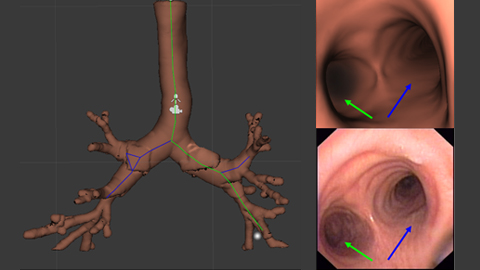Bronchial GPS helps in early detection of lung cancer

16/01/2017
The objective of this collaboration is to improve the existing technology in bronchoscopy without adding new instruments during the procedure, as well as to make the intervention quicker, more effective and cheaper when obtaining biopsies, crucial for the early detection of lung cancer.
The team developing this technology is formed by specialists in artificial intelligence and doctors, coordinated by Dèbora Gil, mathematician and researcher at the Computer Vision Centre and lecturer of Computer Science at the UAB and by Antoni Rosell, pneumologist and researcher at the Hospital de Bellvitge - Idibell.
Current technology acts as a GPS of the lung. It allows pneumologists to plan the route towards the possible tumour and even choose which type of tool to use to obtain a biopsy: tongs, brush or needle. With the help of computer vision techniques and 3D modelling, an exact virtual replica of the patient's lung can be made. This replica is then introduced into a software which, using graphic techniques from video games, emulates a bronchoscopy navigating through the patient's trachea and bronchi to the marked target, and then chooses the diagnosis tool which will finally be used. This simile of a "video game", which acts as a locator map, could not only facilitate and reduce the costs of bronchoscopy procedures, it could also drastically reduce the number of failed interventions, thus avoiding having to repeat interventions with patients.
This technology also has others applications. It allows the precise measurement of different parts of the bronchial system to design personal prosthesis to the millimetre, with all the advantages that poses. Finally, the software can offer a reliable estimation of tracheal stenosis (narrowing of the windpipe) in merely a few seconds. Until now, this diagnosis was done visually and depended on the experience of the doctor assigned. Thus, researchers have found a diagnosis tool which does not rely on subjectivity and offers an objective and precise answer.